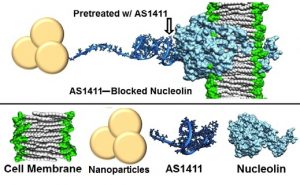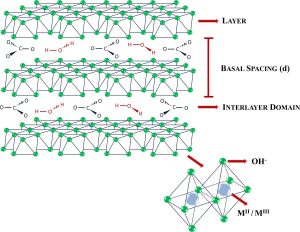Research
- Biomaterials engineering
The design of new biocompatible drug delivery systems is one of the major research axes of our lab in order to obtain novel nanomedicines. In this context, the preparation of pegylated nanocarriers (liposomes and micelles) is extensively investigated. Moreover, drug delivery systems based on pH and/or thermo-sensitive amphiphilic copolymers, such as PCL-g-PNVCL, PCL-g-P(NVCL-co-PNVP), P2VP-b-PEO are studied. Finally, aptamer-functionalized or magnetic polysaccharide-coated nanoparticles are prepared in order to provide an active targeting.
Fig. 1. The nucleolin-targeting nanoparticles used for the delivery of antitumoral drugs
- Polysaccharide-based drug delivery systems
Utilization of polysaccharide as biomaterials has greatly impacted the advancement of modern medicine. Polysaccharides exhibit a huge structural and chemical diversity, and due to their biochemical similarity with human extracellular matrix components are readily recognized and accepted by the body. On one hand, their mucoadhesion, which provides neutral coatings with low surface energy, prevents the nonspecific protein adsorption. On the other hand, the high amount of hydroxyl groups in the polysaccharide backbone allows the incorporation of different specific ligands in order to obtain functionalized colloidal systems. Polysaccharide-based nanoparticles have received considerable attention in the last years as one of the most promising nanoparticulate drug delivery systems owing to their unique characteristics. The attractiveness of these systems for medical purposes is based on their important and unique features, such as their much higher surface to mass ratio, their quantum properties and their ability to absorb or to encapsulate high quantities of active principles. Chitosan, alginate, hyaluronic acid, dextran, guar gum, pectin and cellulose are ones of the most commonly used polysaccharides in the preparation of different types of drug delivery systems.
The choice of different natural or synthetic polymers for the preparation of nanoparticles as drug delivery systems in order to increase the therapeutic benefit and to minimize side effects depends on many factors such as: nanoparticles size, drug solubility and stability, degree of biodegradability, biocompatibility and toxicity.
In our lab, micro and nanospheres, nanocapsules and hydrogels based on natural and synthetic polymers are prepared and charachterzed, as follows:
– nanocapsules based on chitosan (CS) and synthetic polymers such as: poly(maleic anhydride-alt-vinyl acetate)-poly(MAVA) and poly (N-vinylpyrrolidone-alt-itaconic anhydride)- poly (NVPAI) are obtained by the interfacial condensation method (which leads to the formation of nanocapsules in normal conditions of temperature and pressure, without the need of additional cross-linking agents).
– micro and nanospheres based on CS/gelatin and CS/ poly(vinyl alcohol) prepared by double crosslinking of both polymers in the aqueous phase of a water in-oil emulsion (a polymers solution dispersed in toluene). The ionic crosslinking using sodium sulphate was followed by a covalent crosslinking with glutaraldehyde.
– hydrogels based on natural (CS, gelatin, pectin, xantan) and synthetic polymers [poly(MAVA) and poly (NVPAI)]
- Liposomes
Liposomes are phospholipid bilayer vesicles with a diameter ranging from a minimal diameter of 20 nm to several microns. Lipids, (the main component of cell membranes and liposomes) can be both natural and synthetic. The natural lipids most frequently used to obtain liposomes are sphingomyelins, lecithins, etc., which are extracted from egg yolk, soya beans etc.; the synthetic lipids include chains of dimyristoyl, dipalmitoyl, distearoyl, and dioleoyl. Lipids are amphiphilic molecules with both hydrophilic and hydrophobic functional groups, which enable a possible self-assembly in an aqueous medium to form structures as liposomes. Thus, liposomes can encapsulate hydrophilic drugs in the aqueous core and lipophilic drugs within the double-layered lipidic membrane.
The most common methods used for the preparation of liposomes and the main types of liposomes are summarized in the figure 2.
Fig 2: Preparation methods, types and dimensional characteristics of liposomes.
- Colloidal systems
Colloid science deals with small units of matter (gas, liquid, or solid) with sizes in the range of 1nm to1 μm. Typical colloidal systems are represented by solids dispersed in liquids (dispersions), liquids dispersed in liquids (emulsions), liquids or solids dispersed in gas (aerosols) and gases dispersed in liquids (foams). The processes illustrated in Fig. 3 are the typical colloidal systems studied in our lab.
Fig. 3. Typical colloidal systems investigated in the Biomaterials Department of UAI.
(A) Self-assembly of block and graft copolymers (micellization) and their migration to air-water interfaces;
(B) Non-aqueous and aqueous emulsions (droplets of one liquid dispersed in a second liquid) stabilized by polymeric surfactants which lower the energy of the interface;
(C) Electro-steric stabilization of colloidal particles by ionic copolymers;
(D) Steric stabilization of colloidal particles by adsorption of non-ionic copolymers.
- Polysaccharide based hydrogel microparticles with applications in the food industry
The biocatalytic processes underlie many of the technologies currently used not only in the food, but also pharmaceutical, cosmetic or even chemical industries, which determine a continuing concern of researchers in the field. Most of the time, the technological processes are discontinued, and the biocatalyst – microorganism, cell, enzyme – is difficult to remove from the reaction medium. Moreover, it can no longer be reused as any other classical catalyst and the purification operations are complicated. These few aspects explain the continuing research in the field, which essentially concerns the immobilization of various types of biocatalysts on non-toxic supports, leading to the creation of new readily recoverable formulations from the environments in which they work, capable of being reused by a higher number of times in discontinuous processes, or longer use in continuous processes.
An important category of products of interest, not only from the food point of view but also from the health benefits, are nutraceuticals. Their often low solubility and bioavailability require that formulations be developed to improve these characteristics.
Three research directions have been outlined, determined by the nature of the immobilized biologically active compound:
– bioreactors for glucose fermentation.
– bioreactors for starch hydrolysis.
– biopolymer systems for the immobilization and controlled release of nutraceuticals.
- Composites
In the last decade, the theoretical and experimental research on synthesis and characterization of nanostructured systems have seen a strong development. The synthesis of new nanometric nanoparticles as well as the development of experimental techniques offer new opportunities in the development of nanostructures and nanostructured materials as well as in their use in different application areas. The scope of our laboratory is to obtain new nanostructured systems based on oxides (ZnO, TiO, AgO, AuO), metals (Zn, Ti, Ag, Au) and / or polymers, using relatively inexpensive methods: sol-gel, arc discharge, electrofilation, spiraling, spraying, electrodeposition to show properties of materials with applications in medicine.
Layered double hydroxides are a class of anionic clays with a brucite like structure, where the octahedral hydroxyl layers have a positive charge balanced by interlayer counter anions (Fig. 4).
The main properties of these materials are high surface area, diverse composition, anion exchange capacity, enabling the application of these nanostructures in areas such as photocatalysis, environment, medicine, etc.
Fig. 4. Schematic representation of layered double hydroxides structure
An important feature of layered double hydroxides is the structural memory effect, which offers the possibility of intercalation of various organic and inorganic anions in the interllamelar gallery. This effect is based on the reconstruction of the anionic clay, which was subjected to a thermal process in aqueous solutions containing different anions, thus giving rise to nanostructured assemblies of type hybrids derived from layered double hydroxides. Also, the mixed metal oxides derived from thermal decomposition of layered double hydroxides provide, due to the special properties they possess, applications in many fields. Inorganic and organic hybrid materials derived from layered double hydroxides have a high applicability in many specialized fields, due to the many advantages presented by these nanoarchitectures such as: versatile composition, high biocompatibility and increased stability.
Therefore, our main objectives are the following:
- Obtain new formulations based on nanostructured materials type layered double hydroxides and derived hybrids.
- Use the lamellar matrix type layered double hydroxides as components of a specific nanoarchitecture. Ø Study the nano-architectonics of the nanostructured assemblies type LDHs and derived hybrids using transmission electron microscopy (TEM) and scanning electron microscopy (FESEM).
- Study the physico-chemical characteristics of the nanostructured materials type layered double hydroxides and derived hybrids using: X-ray diffraction (XRD), Fourier transform spectroscopy (FTIR), thermal analysis (TG-DTG), Energydispersive X-ray spectroscopy (EDX), X-ray fluorescence (XRF), Ultraviolet–visible spectroscopy (UV-Vis), X-ray photoelectron spectroscopy (XPS) and Raman spectroscopy.
- Study the applications of the nanoarchitectures type LDHs as complex delivery systems and new efficient photocatalytic formulations.






